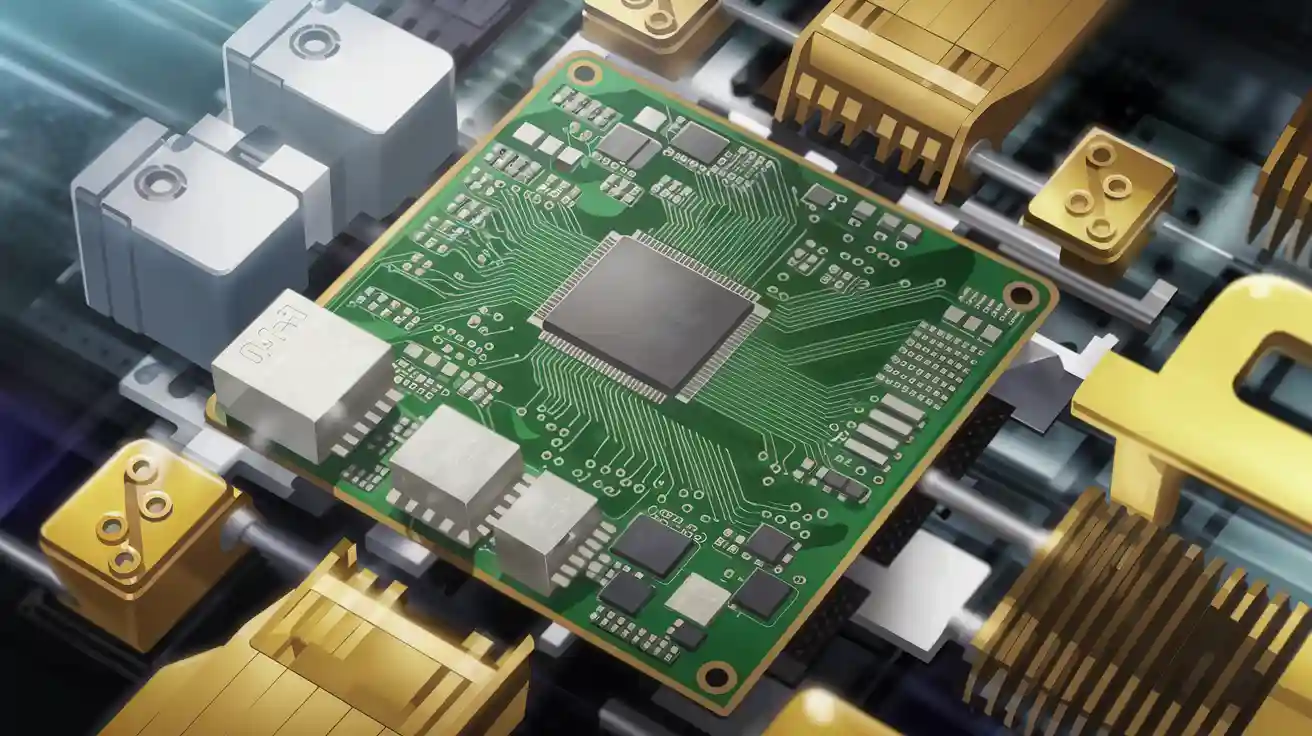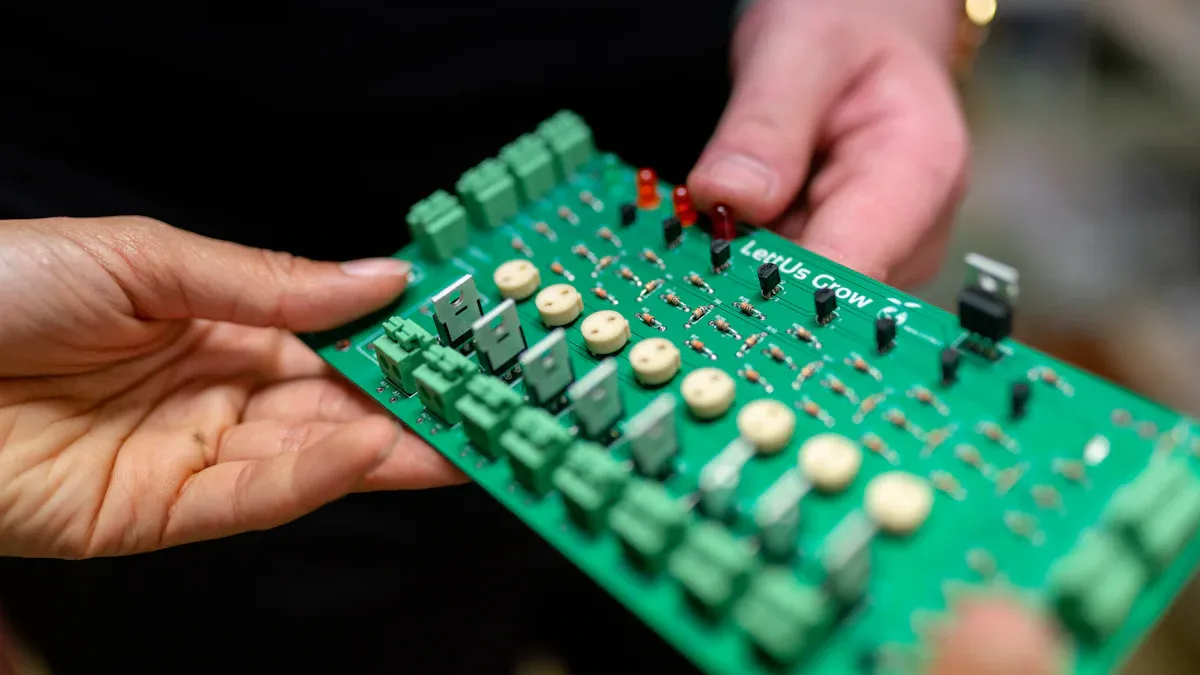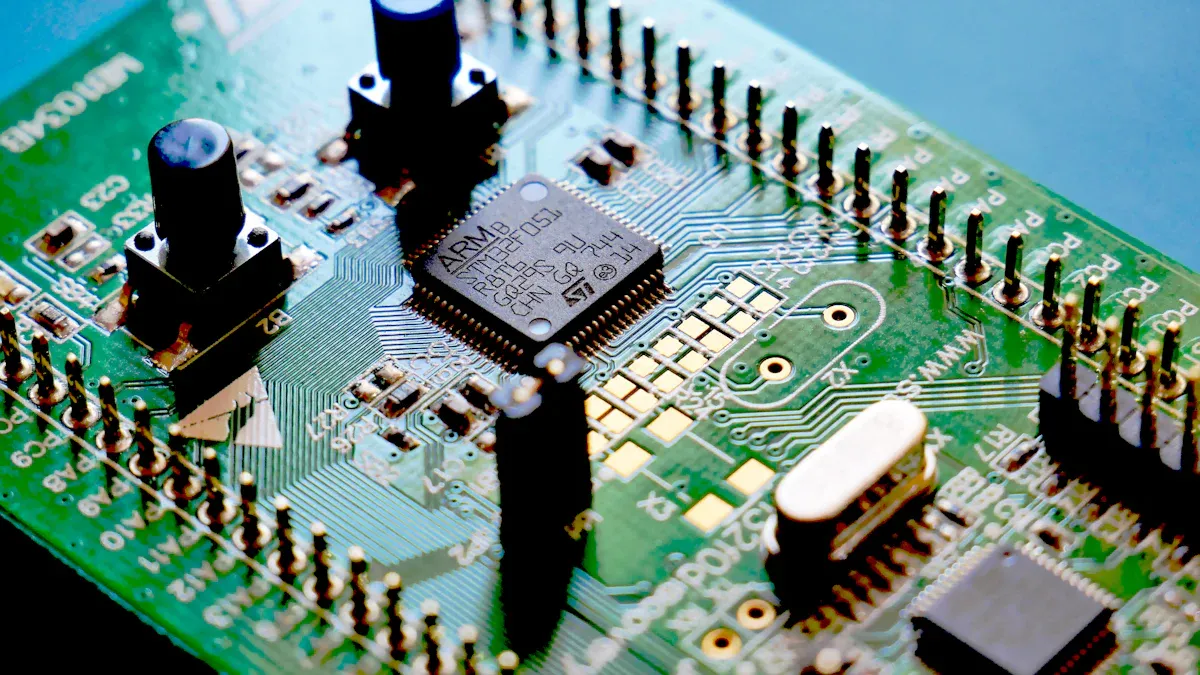Review of the Best Actuator PCBs for Industrial Efficiency
In industrial systems, precision and reliability are essential for maintaining operational efficiency. You rely on actuator PCBs to bridge the gap between mechanical components and electronic controls. These specialized circuit boards enable precise motion control, ensuring that industrial equipment operates with minimal errors. By optimizing energy consumption and managing heat effectively, they also contribute to sustainability. Whether you’re automating a production line or enhancing robotics, an actuator PCB plays a critical role in achieving seamless integration and superior performance.
Key Takeaways
- Pick actuator PCBs that are strong and dependable for tough jobs. This helps cut down on repairs and saves money.
- Choose PCBs with precise controls to avoid mistakes and work better.
- Get PCBs that fit with many systems for easy setup and use.
- Focus on energy-saving PCBs that handle heat well to save money and help the environment.
- Check out models like the CAHB2x for great durability and the HDI for small spaces.
Key Features of High-Quality Actuator PCBs
Durability and Reliability
When selecting an actuator PCB for industrial applications, durability and reliability are non-negotiable. You need a PCB that can withstand harsh environments, including extreme temperatures, vibrations, and exposure to chemicals. High-quality actuator PCBs often meet ISO 9001 standards, ensuring consistent manufacturing processes and superior quality control. These standards guarantee that the PCB will perform reliably over extended periods, reducing downtime and maintenance costs. Additionally, advanced reliability testing, such as 500-hour stress tests, ensures that the PCB can handle prolonged operational demands without failure.
Precision and Accuracy in Control
Precision is critical in industrial systems where even minor errors can lead to significant inefficiencies. High-end actuator PCBs excel in delivering accurate control metrics, enabling seamless operation of machinery. For instance, these PCBs achieve solder paste printing tolerances of ±0.015mm and component misalignment tolerances of ±0.01mm. Such precision minimizes defects and ensures optimal performance. Below is a table showcasing key precision control metrics:
| Metric | Value |
|---|---|
| Solder Paste Printing Tolerance | ±0.015mm |
| Selective Soldering Hole Fill | 99.5% |
| Reliability Testing Duration | 500 hours |
| B10 Lifetime Prediction | >100,000 hours |
| Defect Detection Rate | 99.8% |
| Component Misalignment Tolerance | ±0.01mm |
These metrics highlight the exceptional accuracy and reliability you can expect from a high-quality actuator PCB, making it an indispensable component in industrial automation.
Compatibility with Industrial Systems
Industrial environments often involve diverse machinery and systems. A high-quality actuator PCB must integrate seamlessly with existing setups. You should look for PCBs designed with versatile interfaces and robust communication protocols, such as CAN bus or Ethernet. This compatibility ensures that the PCB can adapt to various industrial applications, from robotics to energy management systems. Furthermore, the PCB’s design should prioritize ease of installation and maintenance, allowing you to focus on optimizing your operations rather than troubleshooting compatibility issues.
Energy Efficiency and Heat Management
Energy efficiency is a critical factor when evaluating an actuator PCB for industrial applications. Efficient energy use not only reduces operational costs but also minimizes the environmental impact of your systems. High-quality actuator PCBs are designed to optimize power consumption by incorporating advanced energy-saving technologies. For instance, many modern PCBs use low-power components and intelligent power management systems to ensure that energy is only consumed when necessary.
Heat management is equally important in maintaining the longevity and performance of your actuator PCB. Excessive heat can degrade components, leading to system failures and costly downtime. To address this, manufacturers integrate features like thermal vias, heat sinks, and advanced copper layering techniques. These design elements dissipate heat effectively, keeping the PCB within safe operating temperatures even during prolonged use.
Tip: Look for PCBs with built-in temperature sensors. These sensors monitor heat levels in real-time, allowing you to take preventive measures before overheating becomes an issue.
Another key consideration is the use of materials with high thermal conductivity. For example, aluminum-backed PCBs are excellent for applications requiring superior heat dissipation. Additionally, some PCBs feature conformal coatings that protect against thermal stress and environmental factors, further enhancing durability.
By prioritizing energy efficiency and heat management, you can ensure that your actuator PCB delivers consistent performance while reducing energy waste. This approach not only improves system reliability but also aligns with sustainability goals, making it a smart choice for modern industrial operations.
Top Actuator PCBs for Industrial Applications
CAHB10 Actuator PCB: Features, Specifications, and Benefits
The CAHB10 actuator PCB stands out for its robust design and exceptional performance in industrial environments. You can rely on this PCB for applications requiring high durability and precision. Its advanced manufacturing process adheres to ISO 9001 standards, ensuring consistent quality and reliability. The CAHB10 integrates seamlessly with various industrial systems, thanks to its versatile communication protocols, including CAN bus and Modbus.
Key Features:
- Durability: Designed to withstand extreme temperatures and vibrations, making it ideal for harsh industrial conditions.
- Precision Control: Offers solder paste printing tolerances of ±0.015mm and component misalignment tolerances of ±0.01mm.
- Energy Efficiency: Incorporates low-power components and intelligent power management systems to reduce energy consumption.
- Heat Management: Features thermal vias and heat sinks for effective heat dissipation during prolonged operations.
Benefits:
- Reduces downtime and maintenance costs due to its reliability.
- Enhances operational efficiency with precise motion control.
- Supports sustainability goals by optimizing energy usage.
Tip: If your application involves high-temperature environments, consider the CAHB10 for its superior heat management capabilities.
CAHB2x Actuator PCB: Features, Specifications, and Benefits
The CAHB2x actuator PCB is engineered for demanding industrial applications where reliability and performance are paramount. This PCB undergoes rigorous testing to ensure its effectiveness in various scenarios. Its compatibility with diverse actuator models makes it a versatile choice for automation systems.
Key Features:
- Reliability Testing: Includes damp heat tests, thermal cycling, and vibration testing to verify durability under extreme conditions.
- High-Potential Testing: Ensures dielectric strength with 1,500V AC for one minute without arcing.
- Solder Joint Integrity: Monitored using X-ray inspection after mechanical shock testing.
Test Results:
| Test Type | Description |
|---|---|
| Current-Carrying Capacity | Confirmed via IPC-2152 standard calculations for 10°C temperature rise. |
| Damp Heat Tests | Conducted 1,000-hour tests at 85°C/85% RH per IEC 60068-2-78 standards. |
| Thermal Cycling | Performed 200 cycles from -40°C to +125°C with 15-minute dwell times. |
| Solder Joint Integrity | Monitored using X-ray inspection after mechanical shock testing (50G, 11ms). |
| Insulation Resistance Test | Applied 500V DC to ensure >100 MΩ resistance. |
| High-Potential Testing | Verified dielectric strength with 1,500V AC for 1 minute without arcing. |
| Peel Strength Testing | Measured adhesion between copper layers and substrate (minimum 1.5 N/mm). |
| Vibration Testing | Exposed PCB to 2–200 Hz vibrations (20G amplitude). |
| Thermal Imaging | Used infrared camera to map hotspots during operation. |
Benefits:
- Guarantees long-term reliability through extensive testing.
- Adapts to various actuator models, enhancing system flexibility.
- Minimizes operational risks with robust insulation and vibration resistance.
Note: The CAHB2x is ideal for applications requiring high reliability and resistance to environmental stress.
HDI Actuator PCB: Features, Specifications, and Benefits
The HDI (High-Density Interconnect) actuator PCB is designed for applications demanding compactness and high performance. Its advanced design allows for increased functionality in smaller spaces, making it perfect for robotics and automation systems.
Key Features:
- Compact Design: Utilizes microvias and thin copper layers to achieve high-density interconnects.
- Enhanced Signal Integrity: Reduces electromagnetic interference, ensuring accurate data transmission.
- Thermal Management: Incorporates aluminum-backed layers for superior heat dissipation.
Performance Data:
| Actuator Model | Gear Ratio | Spring Stiffness (Non-Linear) | Output Bearing Capacity |
|---|---|---|---|
| T5-1 | 272.222 : 1 | Min: ~10 Nm / rad Max: ~50 Nm / rad | Static: 2.2 kN Dynamic: 3.0 kN Static: 5.1 kN Dynamic: 6.9 kN Static: 55.6 Nm Dynamic: 75.5 Nm |
| T5-4 | 762.222 : 1 | Min: ~20 Nm / rad Max: ~200 Nm / rad | |
| T5-9 | 1742.222 : 1 | Min: ~50 Nm / rad Max: ~500 Nm / rad |
Benefits:
- Saves space without compromising functionality, ideal for compact systems.
- Improves operational efficiency with reduced signal interference.
- Extends lifespan through effective heat management.
Tip: Choose the HDI actuator PCB for applications where space constraints and high performance are critical.
Lab-on-PCB Actuator PCB: Features, Specifications, and Benefits
The Lab-on-PCB actuator PCB represents a cutting-edge solution for applications requiring compact, multifunctional designs. This PCB integrates microfluidic channels directly onto the board, enabling precise control of fluid dynamics in industrial and automotive systems. You’ll find this technology particularly useful in scenarios where space is limited, and high precision is essential.
Key Features:
- Integrated Microfluidics: The Lab-on-PCB design incorporates microfluidic channels, eliminating the need for external tubing and reducing system complexity.
- High Precision: Offers exceptional control over fluid flow rates, making it ideal for applications like chemical dosing or lubrication systems.
- Compact Design: Combines electrical and fluidic components on a single board, saving valuable space in your equipment.
- ISO 9001 Compliance: Manufactured under strict quality standards to ensure reliability and consistency.
Specifications:
| Parameter | Value |
|---|---|
| Fluid Flow Tolerance | ±0.01 µL/min |
| Operating Temperature | -40°C to +85°C |
| Material Compatibility | Resistant to oils, solvents, and chemicals |
| Communication Protocols | CAN bus, I2C |
Benefits:
- Enhanced Efficiency: By integrating fluidic and electronic components, you can streamline your system’s design and reduce assembly time.
- Improved Reliability: The ISO 9001-compliant manufacturing process ensures consistent performance, even in demanding environments.
- Versatile Applications: Suitable for automotive fuel injection systems, industrial chemical processing, and precision lubrication systems.
Tip: If your project involves fluid control in tight spaces, the Lab-on-PCB actuator PCB offers an unmatched combination of precision and compactness.
Rigid Flex Actuator PCB: Features, Specifications, and Benefits
The Rigid Flex actuator PCB combines the durability of rigid boards with the flexibility of flexible circuits. This hybrid design allows you to create systems that require both structural support and dynamic movement, making it a popular choice in robotics and automotive applications.
Key Features:
- Hybrid Design: Combines rigid and flexible layers to support both static and dynamic components.
- Durability: Withstands repeated bending and flexing without compromising performance.
- Lightweight Construction: Reduces the overall weight of your system, improving energy efficiency.
- Advanced Heat Management: Features thermal vias and copper layers to dissipate heat effectively.
Specifications:
| Parameter | Value |
|---|---|
| Bend Radius | Minimum 1.5mm |
| Layer Count | Up to 12 |
| Operating Temperature | -55°C to +125°C |
| Signal Integrity | Maintains <1% signal loss |
Benefits:
- Space Optimization: The flexible sections allow you to route circuits through tight spaces, maximizing design efficiency.
- Extended Lifespan: The robust construction ensures long-term reliability, even in high-vibration environments.
- Wide Compatibility: Works seamlessly with actuators in automotive steering systems, industrial robotics, and aerospace applications.
Note: For systems requiring both rigidity and flexibility, the Rigid Flex actuator PCB offers the perfect balance of strength and adaptability.
Comparison Table of the Best Actuator PCBs
Side-by-Side Comparison of Features
When evaluating actuator PCBs, comparing their features side by side helps you identify the best fit for your industrial needs. Below is a table summarizing the key features of the top actuator PCBs discussed earlier:
| PCB Model | Durability | Precision | Energy Efficiency | Compatibility | Heat Management |
|---|---|---|---|---|---|
| CAHB10 | High resistance to extreme conditions | ±0.015mm solder paste tolerance | Low-power components and smart power management | Supports CAN bus and Modbus | Thermal vias and heat sinks |
| CAHB2x | Tested for vibration, thermal cycling, and damp heat | X-ray monitored solder joints | Optimized for long-term reliability | Adapts to diverse actuator models | Infrared thermal imaging |
| HDI | Compact yet durable design | Enhanced signal integrity | Efficient use of space and energy | Ideal for robotics and automation | Aluminum-backed layers |
| Lab-on-PCB | ISO 9001-compliant manufacturing | ±0.01 µL/min fluid flow tolerance | Integrated microfluidics reduce energy waste | Compatible with automotive and industrial systems | Conformal coatings for thermal stress |
| Rigid Flex | Withstands repeated bending | Maintains <1% signal loss | Lightweight construction improves efficiency | Works with automotive and aerospace systems | Thermal vias and copper layers |
This table highlights the strengths of each PCB model, helping you make an informed decision based on your specific requirements.
Tip: If your application involves compact spaces, consider the HDI or Lab-on-PCB models for their space-saving designs.
Performance Metrics and Cost Analysis
Performance metrics and cost are critical factors when selecting an actuator PCB. Below is an analysis of how these PCBs perform in real-world scenarios and their associated costs:
Performance Metrics:
| PCB Model | Reliability Testing | Signal Integrity | Thermal Resistance | Operational Lifespan |
|---|---|---|---|---|
| CAHB10 | 500-hour stress tests | High | Excellent | >100,000 hours |
| CAHB2x | 1,000-hour damp heat tests | High | Excellent | >150,000 hours |
| HDI | Compact design, robust testing | Superior | Good | >80,000 hours |
| Lab-on-PCB | ISO-certified testing | Exceptional | Excellent | >120,000 hours |
| Rigid Flex | Vibration and bending tests | High | Excellent | >200,000 hours |
Cost Analysis:
| PCB Model | Price Range | Value for Money |
|---|---|---|
| CAHB10 | $50–$70 | High |
| CAHB2x | $60–$90 | Very High |
| HDI | $40–$60 | Moderate |
| Lab-on-PCB | $70–$100 | High |
| Rigid Flex | $80–$120 | Very High |
The CAHB2x and Rigid Flex models offer the best reliability and operational lifespan, making them ideal for long-term applications. However, if you prioritize cost-effectiveness, the HDI model provides a balance between performance and affordability.
Note: While the initial cost of the Rigid Flex PCB may seem high, its extended lifespan and durability can reduce long-term expenses.
By analyzing these metrics, you can align your choice of actuator PCB with your budget and performance expectations.
Applications and Use Cases
Enhancing Efficiency in Manufacturing Lines
You can significantly improve manufacturing line efficiency by integrating actuator PCBs into your systems. These PCBs enable precise motion control, ensuring machinery operates with minimal errors. For example, in assembly lines, actuator PCBs help synchronize robotic arms, conveyors, and other equipment. This synchronization reduces production bottlenecks and enhances throughput.
High-quality actuator PCBs, manufactured under ISO 9001 standards, ensure reliability even in demanding environments. Their durability minimizes downtime caused by mechanical failures. Additionally, their compatibility with industrial communication protocols, such as CAN bus, simplifies integration with existing systems. By adopting actuator PCBs, you can streamline operations and achieve consistent product quality.
Optimizing Robotics and Automation Systems
In robotics and automation, actuator PCBs play a pivotal role in achieving precision and adaptability. You can use these PCBs to control robotic joints, enabling smooth and accurate movements. For instance, in automotive manufacturing, robots equipped with actuator PCBs can perform tasks like welding, painting, and assembly with exceptional accuracy.
The compact design of modern actuator PCBs allows you to integrate them into space-constrained robotic systems. Features like advanced heat management and energy efficiency ensure optimal performance during prolonged operations. By leveraging actuator PCBs, you can enhance the flexibility and productivity of your automation systems.
Improving Energy Management in Industrial Equipment
Actuator PCBs contribute to better energy management in industrial equipment by optimizing power consumption. You can rely on their intelligent power management systems to reduce energy waste. For example, in HVAC systems, actuator PCBs regulate airflow and temperature with precision, ensuring efficient energy use.
Their advanced heat dissipation features, such as thermal vias and copper layers, prevent overheating, extending the lifespan of your equipment. Additionally, the use of low-power components aligns with sustainability goals, helping you reduce operational costs and environmental impact. Incorporating actuator PCBs into your energy management systems ensures consistent performance and long-term savings.
Real-World Case Studies of Successful Implementations
Actuator PCBs have transformed industrial operations across various sectors. Below are some real-world examples that highlight their impact on efficiency and innovation.
1. Automotive Manufacturing: Enhancing Precision in Assembly Lines
In the automotive industry, actuator PCBs have revolutionized assembly line operations. A leading car manufacturer integrated HDI actuator PCBs into robotic arms for welding and painting tasks. These PCBs provided precise motion control, reducing errors and improving production speed.
Result: The company reported a 15% increase in production efficiency and a 20% reduction in material waste. The compact design of the HDI PCBs also allowed for seamless integration into existing robotic systems.
2. Energy Sector: Optimizing Wind Turbine Performance
A renewable energy company utilized Rigid Flex actuator PCBs in their wind turbines. These PCBs enabled precise control of blade angles, optimizing energy capture even in fluctuating wind conditions. The hybrid design of the Rigid Flex PCB ensured durability under constant mechanical stress.
Outcome: The turbines achieved a 10% improvement in energy output. Additionally, the robust construction of the PCBs reduced maintenance costs by 25%.
3. Pharmaceutical Industry: Streamlining Chemical Dosing Systems
A pharmaceutical firm adopted Lab-on-PCB actuator PCBs for their chemical dosing systems. These PCBs integrated microfluidic channels, allowing for accurate control of fluid flow rates. This innovation eliminated the need for bulky external tubing, simplifying system design.
Impact: The company experienced a 30% reduction in system assembly time. The precise fluid control also enhanced product quality, meeting stringent regulatory standards.
These case studies demonstrate how actuator PCBs can drive efficiency, reduce costs, and support innovation in diverse industries. By adopting these advanced technologies, you can achieve similar transformative results in your operations.
When selecting an actuator PCB, focus on durability, precision, compatibility, and energy efficiency. These features ensure reliable performance in demanding industrial and automotive environments. The CAHB10 excels in heat management, while the CAHB2x offers unmatched reliability through rigorous testing. The HDI model is ideal for compact systems, and the Lab-on-PCB integrates microfluidics for advanced fluid control. For hybrid designs, the Rigid Flex PCB provides flexibility and strength.
Recommendation: Choose the CAHB2x for its superior reliability and adaptability, especially in high-stress industrial applications.
FAQ
What factors should you consider when choosing an actuator PCB?
Focus on durability, precision, compatibility, and energy efficiency. Evaluate the PCB’s ability to withstand harsh environments, its control accuracy, and its integration with your systems. Prioritize models with advanced heat management and long operational lifespans.
How do actuator PCBs improve energy efficiency?
Actuator PCBs optimize power consumption using low-power components and intelligent power management systems. They reduce energy waste by consuming power only when necessary. Features like thermal vias and copper layers also prevent overheating, ensuring consistent performance and extended equipment lifespan.
Are actuator PCBs compatible with all industrial systems?
Most high-quality actuator PCBs support versatile communication protocols like CAN bus and Ethernet. This ensures seamless integration with diverse machinery and automation systems. Always verify compatibility with your specific equipment before purchasing.
What is the lifespan of a typical actuator PCB?
The lifespan varies by model and application. High-quality PCBs, such as the CAHB2x and Rigid Flex, often exceed 100,000 operational hours. Regular maintenance and proper heat management can further extend their durability.
Can actuator PCBs handle extreme environmental conditions?
Yes, many actuator PCBs are designed for harsh environments. Features like conformal coatings, vibration resistance, and thermal cycling tests ensure reliability under extreme temperatures, humidity, and mechanical stress. Look for models with ISO 9001 compliance for added assurance.






















